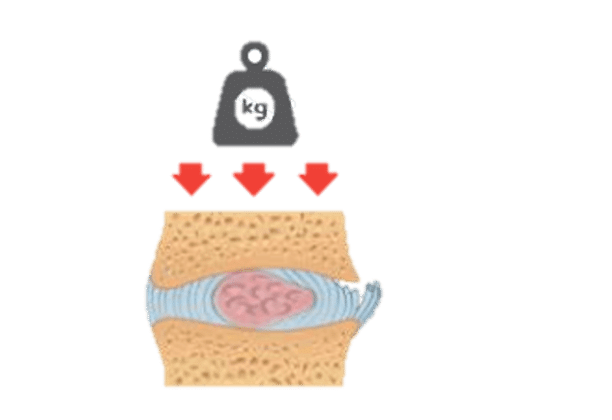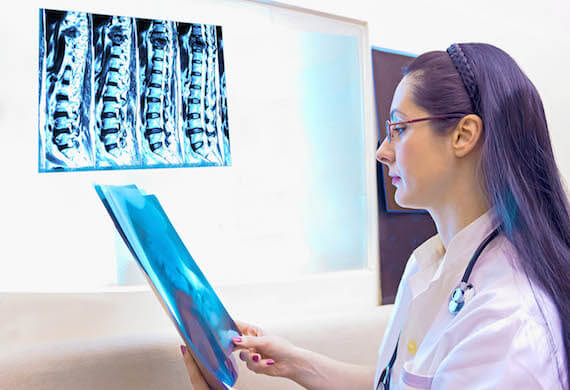Request Appointment
Enter your details and we will be in touch with you shortly;
Or call
8655885566
between 8 am and 8 pm.

Degeneration of bone and cartilage of spine

Spinal arthritis may also be termed as degenerative joint disorder, it is characterized by a gradual disorder of the spine joint that causes stiffness, inflammation, and pain. It often develops from the natural wear and tear on the cartilage, known as degenerative arthritis of the spine.
It’s like your joints have swollen and you are now unable to flex them; they start aching, especially when you have to move, bend over, or try to stand up. This process results in the deterioration of cartilage and subsequent contact or rubbing of vertebral bones. Arthritis is mostly found in elderly people, although there are cases where it might affect young individuals because of injury or neurological disorders.
Arthritis occurs in any part of the spine, but is common in the cervical and lumbar regions. In case of spinal arthritis, patients experience severe back pain and stiffness, particularly in the lower back.
Spinal arthritis causes inflammation and swelling of the joints in the spine, which affects mobility in the spine.
The conditions comprising spinal arthritis can be categorized depending on the cause and area of affected vertebral bodies. Understanding these variants helps in tailoring the appropriate spinal arthritis therapy.
By combining early intervention, targeted exercises, and a comprehensive spinal arthritis treatment program, you can better manage symptoms and maintain spinal health for improved quality of life.
Spinal arthritis also tends to trigger other issues that give rise to new consequences that adversely affect function and comfort. Key issues include:
Early recognition and targeted NSAIDs for spinal arthritis pain, alongside appropriate physical care, can help manage these complications and maintain spinal health.
 Professional diagnosis required
Professional diagnosis required Chronic, can last for years
Chronic, can last for years Treatable with 4 weeks of QI Spine Therapy
Treatable with 4 weeks of QI Spine TherapySpinal arthritis arises from the gradual wear and tear of the spinal joints, commonly known as degenerative arthritis of the spine. Identification of the underlying cause and affected regions is perhaps most vital to finding a lasting resolution, as this allows specialists to provide targeted spinal arthritis treatment. Some of the most common causes of spinal arthritis include:
Understanding the causes of spinal arthritis enables patients to adopt healthy lifestyles to prevent or reduce the progression of the ailment. Timely intervention with spinal arthritis relief treatment is key to preserving long-term quality of life.
Conservative management of spinal arthritis aims at preventing further development of deformity and pain. Through one’s healthy daily practice and early treatment, the grievous spinal deterioration and chronic pain will be minimized.
By combining these preventive measures, individuals can achieve significant spinal inflammation relief while embracing a holistic approach that includes both non-surgical arthritis treatment methods and dedicated physical care. It is for this reason that early identification and follow-up form the core of long-term management for spinal arthritis.
 Professional diagnosis required
Professional diagnosis required Chronic, can last for years
Chronic, can last for years Treatable with 4 weeks of QI Spine Therapy
Treatable with 4 weeks of QI Spine TherapyConventional treatment for spinal arthritis includes medications to reduce pain and inflammation. However, these medications do not treat the underlying problem, which means that patients who are on these medicines will need to continue taking them for life. QI Spine uses some of the most technologically advanced diagnostic and treatment methods to help patients manage their condition and lead healthy, productive lives.
Back surgery has become a common recommendation for spinal problems, including spinal arthritis. However, recent studies show that up to 90% of these surgical procedures are unnecessary and do nothing to improve patient outcomes; in fact, many of these procedures increase the risk of further spinal complications. QI Spine’s holistic and evidence-based treatment protocols offer patients a safer and more effective treatment for spinal arthritis with better long-term benefits.
Treatment protocols are unique to each patient, depending on how the condition has affected them. This allows spine specialists to provide the best spinal arthritis treatment for each patient, depending on their individual requirements. In cases where the pain is severe, the QI Spine team will work with rheumatologists to decide on a medication plan and personalized spinal arthritis relief therapy to ease discomfort so that you can perform medical movements to strengthen the muscles that support the spine. McKenzie's movements are very effective in cases where peripheral joints are involved.
Medications are often the first line of conventional treatment for spinal arthritis, but these drugs often cause serious health problems and can even cause organ damage in the long run.
Spinal arthritis can cause severe and even debilitating pain if left untreated. This is why it is important to visit a spine specialist at the earliest for a definite diagnosis and timely treatment.
 Professional diagnosis required
Professional diagnosis required Chronic, can last for years
Chronic, can last for years Treatable with 4 weeks of QI Spine Therapy
Treatable with 4 weeks of QI Spine TherapyConventional treatment for spinal arthritis includes medications to reduce pain and inflammation. However, these medications do not treat the underlying problem which means that patients who are on these medicines will need continue taking them for life. QI Spine Clinic uses some of the most technologically advanced diagnostic and treatment methods to help patients manage their condition and lead healthy productive lives.
Back surgery has become a common recommendation for spinal problems including spinal arthritis. However, recent studies show that up to 90% of these surgical procedures are unnecessary and do nothing to improve patient outcomes; in fact, many of these procedures increase the risk of further spinal complications. QI Spine’s holistic and evidence- based treatment protocols offer patients a safer and more effective treatment for spinal arthritis with better long-term benefits.
A definite diagnosis is essential for effective treatment but most cases of back pain are classified as “unspecific back pain”. QI Spine Clinic uses the most advanced spine function test – the Digital Spine Analysis (DSA) to pinpoint the muscles and structures that have been affected by spinal arthritis. This test allows QI spine specialists to create targeted treatment protocols in order to strengthen these muscles, improve muscle function, and increase mobility.
Treatment protocols are unique to each patient depending on how the condition has affected them – this allows spine specialists to provide the best spinal arthritis treatment for each patient, depending on their individual requirements. In cases where the pain is severe, the QI team will work with rheumatologists to decide on a temporary medication plan to ease discomfort so that the patient can perform medical movements to strengthen the muscles that support the spine. McKenzie movements are very effective in cases where peripheral joints are involved.
Medications are often the first line of conventional treatment for spinal arthritis but these drugs often cause serious health problems and can even cause organ damage in the long run. However, QI utilizes Frequency Specific Microcurrent (FSM) technology from Germany to reduce spinal arthritis pain. This technology uses a low-level electric current to promote tissue repair, reduce inflammation, and eliminate back pain.
Spinal arthritis can cause severe and even debilitating pain if left untreated. This is why it is important to visit a spine specialist at the earliest for a definite diagnosis and timely treatment
 Professional diagnosis required
Professional diagnosis required Chronic, can last for years
Chronic, can last for years Treatable with 4 weeks of QI Spine Therapy
Treatable with 4 weeks of QI Spine TherapyIn cases of severe instability or deformity, consider Spinal fusion surgery for arthritis. It is a structured format of diagnosis that informs appropriate action to be taken on time to address the situation.
A definite diagnosis is essential for effective treatment, but most cases of spine pain are classified as “nonspecific spine pain”. QI Spine uses the most advanced spine function test, the Digital Spine Analysis (DSA), to pinpoint the muscles and structures that have been affected by spinal arthritis. This test allows our doctors to create targeted treatment protocols to strengthen these muscles, improve muscle function, and increase mobility.
CT scans, MRIs, and X-rays often fail to pinpoint the exact source of pain, whereas DSA directly analyzes muscle tissue to identify the root cause. Here is how DSA is conducted & its benefits:
After the thorough analysis doctor will design a personalized spinal arthritis therapy for you. The therapy follows the whole patient's journey, and our spine doctors will guide you from the first day of consultation to the post-care. Also, the doctor and you can both track the treatment details over QI Spine’s app. The app also allows you to map your exercise routine, schedule your video consultation or in-clinic appointment, and track your recovery progress.
 Professional diagnosis required
Professional diagnosis required Chronic, can last for years
Chronic, can last for years Treatable with 4 weeks of QI Spine Therapy
Treatable with 4 weeks of QI Spine Therapy


Have a question?
Ask our spine specialists
Who is a QI Spine Specialist?
A QI Spine Specialist is a medical expert with

Dr. Nidhi Sanghvi Shah

Dr. Shital Gaikwad

Dr. Richa Bhatia
9000 hours
of specialisation in treating back and neck conditions
32 hours
of spine physiotherapy specialisation methods in McKenzie concepts, Kinetic control, Neurodynamic solutions, Mulligan’s concepts
500 hours
and 6 months of QI Spine specialisation courses
Of course, low-intensity exercises include walking and mild swimming, which aids in reducing stiffness and increasing riots in spinal arthritis. It is possible to walk around, swim, stretch, do gentle pelvic tilt, or incorporate movements from gentle yoga such as cat-cow. Exercise also aids in weight management in a way that tends to lessen the pressure on the spine.
This condition could be managed by pain relievers, physical therapy, changes in lifestyle, and injections at times. Strengthening and flexibility normally includes knee to chest, bird dog, and bridge, among other moves. In the most severe cases of the disease, surgery may be required in a case for a patient.
It can, if not treated, turn into a chronic condition that might require further surgery due to pressure on nerves or cartilage as well as limitation of movement. Timely and proper treatment and follow up also enable the control of symptoms and the maintenance of function. Symptoms range from mild to serious considering the severity of the joint involvement.
Sedentary patients should not engage in activities that cause a lot of stress on the joints, such as running or lifting heavy things. Its activities: The above activities include: Do not sit down for long without stretching, and do not slouch. Not following therapy or going through treatment without professional direction means that an individual will not get relief as soon as possible.